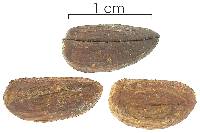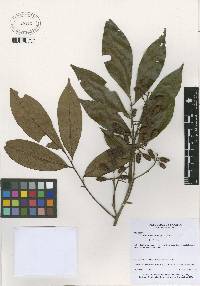

|
|
|
|
Family: Meliaceae
Alfajía, more...camfíne
|
Description: A large but not giant tree of mature forest. Large trees have straight, cylindrical trunks, with no buttresses, branched only near the top. The bark has small, white "tubercles", each consisting of a pair of vertical white bars with a vertical black line in between; the entire tubercle is about 3 mm long. Leaves are alternate, compound, with a pseudo-terminal leaflet. That is, there are really an even number of leaflets, usually 6-8, but one of the last pair bends forward and appears to be terminal. Leaflets are arranged alternately along the leaf rachis, and the basal ones are smaller than the outer ones. The base of the leaf stalk is swollen, but flattened (not cylindrical). There are often small, black circles on leaves, but this is a fungus and is not always present. Reproduction: Fruits are produced at the start of the wet season, and where this species is common, many can be found on the ground. They are small, dark seeds with a bright red aril which does not quite cover the seed. Distribution: Abundant in the old-forest of Barro Colorado Island, where it is one of the dominant trees of the canopy and is very common as a sapling. If you pay close attention, you will find that there are seldom saplings right around an adult, whereas there are concentrations of saplings far from any adult. Apparently there is a fungus associated with adults which tends to kill nearby saplings. Also abundant in the central part of Pipeline Rd and on the peninsulas near Barro Colorado. Present, but at much lower density, throughout the rest of the Canal area lowlands, including both Pacific and Caribbean coasts. Never seen outside the forest. Similar Species: In large trees, the white tubercles are inconspicuous, and can only be found with close inspection (often after rubbing moss away), but no other species has them. In saplings, the way the terminal leaflet is not quite straight is characteristic of many species of Trichilia and sets the genus apart from other Meliaceae like LK guargu Guarea LK2 or LK cedrod Cedrela. LK2 On Barro Colorado and at Pipeline Rd, the other Trichilia is LK tri2pa T. pallida; LK2 it is far less common and has larger leaflets. In other forests of the Canal area, there is usually at least one other Trichilia more abundant than T. tuberculata. The most important is LK tri2pl T. pleeana, LK2 which is common in the drier forests around Panama City; it has more leaflets that are mostly the same size as one another. Descripción: Árbol de 20 a 30 m de alto. Copa redondeada y con follaje denso. Tronco con raíces tablares pequeñas en la base. Corteza exterior negra y con lenticelas blancas. Corteza interior roja. Hojas imparipinnadas y alternas, con 5-9 folíolos, alternos en el raquis, a veces subopuestos. Folíolos de 10-20 x 3-5 cm, elípticos, con ápice acuminado, bordes enteros a ondulados y base decurrente. En plantas juveniles los folíolos pueden presentar puntos circulares negros en ambas superficies, lo cual se debe a la presencia de hongos. Pecíolo de 3-6 cm de largo y ligeramente acanalado en la parte superior. La especie es dioica o polígama. Flores verdes o amarillentas. Frutos en cápsulas, de 1-2 cm de largo, verdes y tuberculados en el exterior, tornándose amarillos o anaranjados y dehiscentes al madurar. Semillas 1 ó 2, envueltas por un arilo rojo. Datos Ecológicos: La especie crece a bajas y medianas elevaciones, en bosques húmedos o muy húmedos. Común y muy abundante en el bosque viejo de la isla de Barro Colorado y la parte central del Canal de Panamá. Florece y fructifica de abril a noviembre. Las flores son visitadas por abejas y otros insectos. Las semillas son dispersadas por la abertura de los frutos y los animales. El arilo que rodea las semillas sirve de alimento a varias especies de monos, tucanes y pavas de monte. Especies Parecidas: A menudo se confunde con LK tri2pl Trichilia pleeana LK2 , pero en T. pleeana el tronco es de color blanco y la corteza es lisa. Usos: La madera es empleada en construcciones pesadas, puentes, postes de cercas, entarimados y pisos industriales. En Panamá es utilizado para leña debido a que tiene la propiedad de arder cuando está verde, de allí uno de sus nombres comunes de ‘fosforito’. |
|
|
|








































